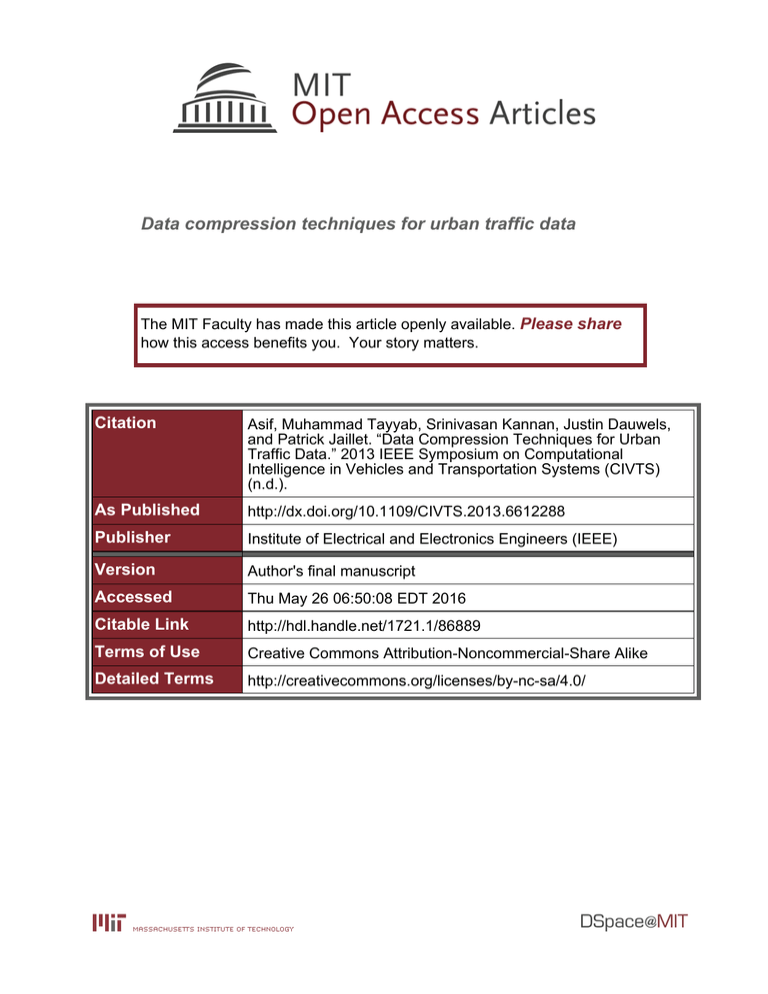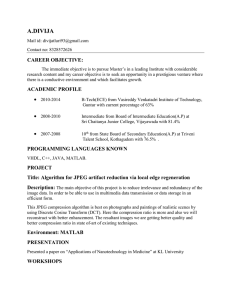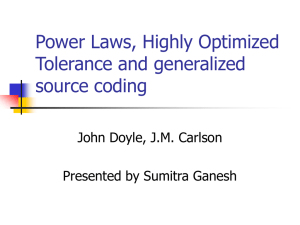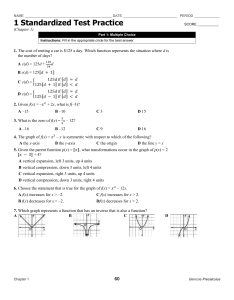Data compression techniques for urban traffic data Please share
advertisement

Data compression techniques for urban traffic data
The MIT Faculty has made this article openly available. Please share
how this access benefits you. Your story matters.
Citation
Asif, Muhammad Tayyab, Srinivasan Kannan, Justin Dauwels,
and Patrick Jaillet. “Data Compression Techniques for Urban
Traffic Data.” 2013 IEEE Symposium on Computational
Intelligence in Vehicles and Transportation Systems (CIVTS)
(n.d.).
As Published
http://dx.doi.org/10.1109/CIVTS.2013.6612288
Publisher
Institute of Electrical and Electronics Engineers (IEEE)
Version
Author's final manuscript
Accessed
Thu May 26 06:50:08 EDT 2016
Citable Link
http://hdl.handle.net/1721.1/86889
Terms of Use
Creative Commons Attribution-Noncommercial-Share Alike
Detailed Terms
http://creativecommons.org/licenses/by-nc-sa/4.0/
Data Compression Techniques for
Urban Traffic Data
Muhammad Tayyab Asif∗ , Srinivasan Kannan∗ , Justin Dauwels∗ and Patrick Jaillet
†‡
∗ School
of Electrical and Electronic Engineering, Nanyang Technological University, Singapore, 639798
† Laboratory for Information and Decision Systems, MIT, Cambridge, MA, 02139
‡ Center for Future Urban Mobility, Singapore-MIT Alliance for Research and Technology, Singapore
Abstract—With the development of inexpensive sensors such as
GPS probes, Data Driven Intelligent Transport Systems (D2 ITS)
can acquire traffic data with high spatial and temporal resolution.
The large amount of collected information can help improve
the performance of ITS applications like traffic management
and prediction. The huge volume of data, however, puts serious
strain on the resources of these systems. Traffic networks exhibit
strong spatial and temporal relationships. We propose to exploit
these relationships to find low-dimensional representations of
large urban networks for data compression. In this paper, we
study different techniques for compressing traffic data, obtained
from large urban road networks. We use Discrete Cosine
Transform (DCT) and Principal Component Analysis (PCA) for
2-way network representation and Tensor Decomposition for
3-way network representation. We apply these techniques to
find low-dimensional structures of large networks, and use these
low-dimensional structures for data compression.
I. I NTRODUCTION
Data Driven Intelligent Transport Systems (D2 ITS) have
increasingly found greater role in applications such as traffic
management, sensing, route guidance, and prediction [1]–[8].
This has been made possible due to availability of large
amount of data, collected by sensors such as GPS probes and
loop detectors. D2 ITS require traffic data with high spatial
and temporal resolution. Large road networks are typically
divided into thousands of road segments. Data acquisition
systems usually have temporal resolution of 5 minutes. While
the sensors provide detailed information regarding the state
of the network, the large volume of data puts strain on
resources of data management systems [9]. The huge amount
of information also tends to hinder the scalability of many data
driven applications dealing with route guidance and prediction
[10], [11]. For D2 ITS dealing with large road networks, these
problems can potentially compound into serious bottlenecks
[12].
Traffic parameters such as speed, flow and travel time
usually exhibit strong spatial and temporal correlations [5].
Moreover, there exist certain temporal and spatial trends in
traffic data [9], [13]. These relationships have previously been
utilized for applications such as traffic prediction [5], sensing
[4], data imputation [14] and even data compression [9],
[15]. The previous studies related to traffic data compression
have mainly focused on a few intersections [9], [13], [15].
Practical implementations require data compression algorithms
for large and diverse urban networks. In this study, we examine
whether data from a large and diverse urban network can
be compressed without losing a lot of information. To this
end, we consider a road network in Singapore from Outram
park to Changi, comprising of more than 6000 road segments.
The network consists of expressways as well as roads in the
downtown area, and around Singapore Changi Airport. We
propose to exploit the spatial and temporal relations between
traffic parameters to construct low-dimensional models for
large road networks using different subspace methods. We
then use these low-dimensional models for data compression.
Singapore Land Transportation Authority (LTA) provided data
for experimental purposes. It consists of space averaged speed
values for all the road segments for August 2011. In this study,
we do not deal with the problem of missing data imputation.
We only considered those road segments for which adequate
data was available.
We employ methods such as Discrete Cosine transform
(DCT), Principal Component Analysis (PCA) and Higher
Order Singular Value Decomposition (HO-SVD), to find
low-dimensional representations for large networks. Using
these low-dimensional representations, we perform data
compression. We compare their compression efficiency by
calculating reconstruction error for different compression
ratios.
The paper is structured as follows. In section II, we briefly
explain the data set. We propose different data compression
techniques for large networks in section III. In section IV,
we compare the performance of proposed methods. In the
end (section V), we summarize our contributions and suggest
topics for future work.
II. DATA S ET
We define the road network under study, as a directed graph
G = (N, E). E = {si ∣i = 1, ...p} is the set of road segments
(links), where a road segment is denoted by si . We represent
the weight of each link si by z(si ,t j ), which is a time varying
function, representing the average traffic speed during the
interval (t j − t0 ,t j ).
For data compression, we consider a large sub network from
Outram park to Changi in Singapore (see fig. 1). The network
G consists of road segments from three expressways, which are
Pan Island Expressway, East Coast Parkway and Kallang Paya
Lebar Expressway. It also includes the region around Changi
Airport and roads in the downtown area of Singapore carrying
(d,p)
{mi′ j′ = z(s j ,ti )}(i, j)=(1,1) , where i′ = i−1 and j′ = j −1. Using
DCT, we create transformed representation NG of MG in the
following manner:
(2 j′ + 1)π j′′
(2i′ + 1)π i′′
)cos(
),
∑∑
2d
2p
i′ =0 j′ =0
(1)
where 0 ≤ i′′ < d , 0 ≤ j′′ < p. αi′′ and α j′′ are defined as:
ni′′ j′′ = αi′′ α j′′
d−1 p−1
mi′ j′ cos(
⎧
1
⎨ √
√d
αi′′ =
2
⎩
d
⎧
1
√
⎨ p
√
α j′′ =
2
⎩
p
Fig. 1: Road network in Singapore (Outram to Changi).
significant volumes of traffic. The road segments comprising
the setup have different speed limits, lanes, and capacities.
We use space averaged speed data provided by LTA from
August, 2011. For this study, we consider kilometer/hour
(km/hr) as units for traffic speed. Sampling interval for data
t0 is 5 minutes.
III. DATA C OMPRESSION M ETHODS
In this section, we propose different data compression
methods for large networks. We consider two different
formulations for methods dealing with 2-way (matrix) and
3-way (tensor) compression.
For methods dealing with matrix compression, we consider
a network profile MG ∈ Rd×p for network G. Each link
si is represented by a speed profile mi such that {mi =
[z(si ,t1 )z(si ,t2 )...z(si ,td )]T }si ∈E . Hence, the network profile
MG = [m1 m2 ...m p ] contains speed data for p links from time
t1 to td . We use PCA and DCT to obtain low-dimensional
representation XG , of network profile MG .
Traffic parameters tend to exhibit certain daily, repetitive
patterns [14]. To observe the effect of these correlations on
compression efficiency, we consider a 3-way structure for
network profile. For tensor compression, network profile is
defined as a 3-way tensor MG ∈ Rdt ×p×w , such that speed
values {z(si ,t kj )}wk=1 , observed at same time t j , during different
days {lk }wk=1 , are stacked as entries {𝔪i jk }wk=1 of MG . We set
d = dt × w, to keep the total information in MG and MG same.
We use HO-SVD to find compressed representation XG of
network profile MG .
Based on these definitions, we develop following methods
for network data compression.
A. Discrete Cosine Transform
DCT is the workhorse behind JPEG, which is the industry
standard for image compression [16], [17]. The network profile
MG , carrying information regarding network G, can also be
considered as an image. In this case, speed value z(s j ,ti ) for
link s j at time ti can be thought of as a pixel such that
i′′ = 0
(2a)
i′′ = 1, ...d − 1,
(2b)
j′′ = 0
(3a)
j′′ = 1, ...p − 1.
(3b)
Fig. 5 shows the magnitude of frequency components ni′′ j′′ ,
which are stored in NG and plotted on the log scale. The
figure shows that there is a sizable portion of frequency
components, with small magnitude, which can be neglected.
As an example, we consider a small subset of frequency
components Ψ from NG to reconstruct a low-rank network
profile XG (see Fig. 3) of MG (see Fig. 2), using inverse
DCT. For convenience, we show plots for NTG , MTG and XTG
(AT represents transpose of A) in Fig. 5, 2 and 3 respectively.
XG provides a much smoother picture of the network as
compared to MG . This implies that XG failed to capture small
variations in speed, which are present in MG . Fig. 4 shows
HG T , whose entries hi j represent reconstruction error such
∣ mi j − xi j ∣ ×100 i=d, j=p
that {hi j =
}i=1, j=1 . hi j provides us with an
mi j
estimate of reconstruction error for each speed value z(s j ,ti ).
The error distribution in Fig. 4 also reinforces the idea that
XG T needs more frequency components to capture smaller and
relatively local variations in speed profiles.
Nonetheless, XG still preserves the main traffic trends such
as peak hours and off peak hours. The scales in Fig. 2
and 3, represent colors corresponding to the respective speed
values in the figures. The color bar in Fig. 4 represents colors
corresponding to the reconstruction percentage error.
We use the following formula to calculate Compression
Ratio (CR):
CR =
Total number o f elements (Θ)
.
number o f storage elements (θ )
(4)
For DCT compression, ΘDCT = d × p and θDCT = Ψ, hence
d×p
. Another advantage offered by DCT is in
CRDCT =
Ψ
terms of computational complexity. DCT can be computed in
O(N log N) time, using Fast Fourier Transform (FFT), where
N = n × m for A ∈ Rn×m [17].
Fig. 2: Speed profiles of links in MTG . Color bar represents
colors corresponding to different speed values.
Fig. 3: Reconstructed speed profiles of links in XTG using
DCT compression. Color bar represents colors corresponding
to different speed values.
B. Principal Component Analysis
PCA is a particular Karhunen-Loeve (KL) Transform, which
has been employed in many D2 IT S applications including
data compression [9] and missing data imputation [14]. The
previous studies involving PCA in relation to traffic data
compression have been limited to a few intersections [9].
In this study, we analyze the compression efficiency of
PCA for large and diverse networks. Similar to DCT, PCA
transformation tends to de-correlate the components of data
and concentrates energy to small number of basis vectors.
Unlike DCT, however, in case of PCA, the basis vectors
are obtained by eigenvalue decomposition of the covariance
matrix. To calculate covariance matrix Σs , we consider links
p
as variables with observations taken during different
{si }i=1
time intervals. Speed profile mi contains speed values observed
on the link si during the time interval (t1 ,td ). Let us consider
Fig. 4: Error profiles HTG for the links in network G. Color
bar represents colors corresponding to the reconstruction
percentage error.
Fig. 5: Frequency Components stored in NTG . Color bar
represents colors corresponding to log of magnitude of
frequency components ni′′ j′′ .
a variant of network profile Mμ G = [mμ 1 ...mμ p ] obtained by
centering all the speed profiles in MG around their mean
p
, where q ∈ Rd and
values, such that {mμ i = mi − μsi q}i=1
T
q = [11...1] . Speed values across different links, exhibit
strong spatial correlations [5]. This results in a non-diagonal
p
, calculated as
co-variance matrix Σs for variables {si }i=1
Σs =
1 T
M Mμ G .
d μG
(5)
Eigenvalue decomposition of Σs = Φs Δs Φs T will yield
orthonormal vectors Φ = [φs1 φs2 ...φsp ], such that {φsi T φs j =
0}i∕= j , φsi T φsi = 1. The diagonal matrix Δs contains eigenvalues
p
, we can obtain
for Σs . Using the basis vectors {φsi }i=1
p
an uncorrelated subspace{χi }i=1 . The resultant transformed
network profile will be Mχ G = Mμ G Φs . In this case, the
principal components are the transformed speed profiles
Speed Profile
Reconstruction using Σs
60
Reconstruction using Σt
50
40
20
12:05 AM
6:00 AM 12:00 PM 6:00 PM 12:00 AM
Time (HH:MM AM/PM)
Fig. 6: Data reconstruction for a typical link, using just the
1st principal components obtained from Σs and Σt . Principal
components corresponding to basis vectors φs1 and φt1 provide
similar performance.
(6)
where columns of UG and VG are left-singular vectors and
right-singular vectors of MG respectively [18], [19] and:
MG MTG = UG ΛG ΛTG UTG ,
(7)
MTG MG = VG ΛTG ΛG VTG .
(8)
The representations in (7) and (8) are quite similar to (5) and
∑t , baring the scaling factor and mean subtraction. Hence,
compression achieved by either using ∑s or ∑t will provide
similar results [18](see Fig. 6).
Nonetheless, It can be shown that the basis vectors
{Φω }ω ∈{s,t} obtained by eigenvalue decomposition of
{Σω }ω ∈{s,t} provide the optimal linear transformation to rotate
space (si ∈ E) or time(ti ∈ (t1 ,td )) variables to uncorrelated
space [18].
For data reconstruction using PCA, both principal
components Mχ Gr and basis vectors Φsr need to be stored.
So, θPCA = d × r + p × r, ΘPCA = d × p and CR will be
d×p
.
CRPCA =
d ×r+ p×r
70
30
0.35
Proportion of Variance Explained
MG = UG ΛG VTG ,
Speed (km/hr)
p
{mχ i }i=1
. The 1st principal component will be along the
direction of maximum variance (not the historic mean) in
the data and so forth. This transformation allows relatively
small number of principal components to explain most of the
variance in the data. We obtain low-dimensional representation
Xμ G = Mχ Gr ΦTsr (mean centered) of the network G, using
these small number of principal components {Mχ Gr =
[mχ 1 , mχ 2 , ...mχ r ]}r<p , such that {Φsr = [φs1 , φs2 , ...φsr ]}r<p .
It is also interesting to observe the traffic behavior between
different time periods. For this case, let us consider each
time instance {t j }dj=1 as a variable, with speed observations
{z(si ,t j )}si ∈E taken across the network. Σt is the covariance
matrix in this case such that Σt = Φt Δt Φt T . Δt and Δs provide
a measure of how much variance the corresponding principal
components can explain. It may seem from Fig. 7 and 8
that Σt will provide better compression as the 1st principal
component explains around 90% of variance in the data.
However, this might be misleading. If we consider Singular
Value Decomposition (SVD) of MG , we get:
0.3
0.25
0.2
0.15
0.1
0.05
0
1
2 3 4 5 6 7 8 9 10
Number of Principal Components
Fig. 7: Proportion of variance in Σs explained by principal
components.
(9)
C. Data Compression using Tensor Decomposition
Tensor based methods have found applications in many
fields including Chemometrics [20], telecommunications [21]
and neuroscience [22], [23]. In this section, we propose a
tensor based compression method for traffic data. Techniques
such as PCA and DCT consider a 2-way representation of
the network G. However, observations taken at the same time
on different days may also correlate strongly [9]. To utilize
these daily patterns for compression, we consider a 3-way
network profile MG ∈ Rdt ×p×w of G. We consider Higher
Order Singular Value Decomposition (HO-SVD) [24]–[26] for
data compression, using 3-way representation of the network.
Using HO-SVD, we can decompose the network profile MG
as [24], [25]:
MG = CG ×1 Y(1) ×2 Y(2) ×3 Y(3) ,
(10)
where CG ∈ Rdt ×p×w is called core tensor and matrix
{Y(n) }3n=1 contains n-mode singular vectors of MG [25].
F = A ×n B is called the n-mode product between the tensor
A ∈ RI1 ×I2 ...In ...IN and the matrix B ∈ RJn ×In . Entries for F
∈ RI1 ×I2 ...In−1 ×Jn ...IN are calculated as:
fi1 i2 ...in−1 jn ...iN = ∑ ai1 i2 ...in−1 jn ...iN b jn in .
(11)
in
For data compression, we estimate MG by a low-rank tensor
XG using the low rank core tensor CGr ∈ Rr1 ×r2 ×r3 and
15
0.8
10
PRD (%)
Proportion of Variance Explained
1
0.6
0.4
5
PCA
DCT
HO−SVD
0.2
0
0
1
2
2 3 4 5 6 7 8 9 10
Number of Principal Components
Fig. 8: Proportion of variance in Σt explained by principal
components.
4
6
8
Compression Ratio
10
Fig. 9: Compression efficiency of different techniques.
IV. R ESULTS AND D ISCUSSION
corresponding matrices W(1) ∈ Rdt ×r1 , W(2) ∈ R p×r2 and
W(3) ∈ Rw×r3 containing singular vectors for their respective
modes [25].
For reconstruction, we need to store CGr as well as W(1)
W(2) and W(3) . So ΘHOSV D = dt × p × w, θHOSV D = r1 × r2 ×
r3 + dt × r1 + p × r2 + w × r3 and CR will be
CRHOSV D =
dt × p × w
.
r1 × r2 × r3 + dt × r1 + p × r2 + w × r3
(12)
D. Compression Efficiency
We use percent root-mean-square distortion (PRD) [23],
[27] to compare compression efficiency of proposed methods.
PRD is also often referred as Relative error [28], [29]. It
is a commonly used performance metric for low-dimensional
estimation of matrices and tensors [23], [27]–[29]. PRD can
be considered as a measure of energy loss in the reconstructed
network profile XG (XG ) as compared to the original profile
MG (MG ). PRD for matrices is calculated as:
PRDM (%) =
∥ MG − XG ∥F
× 100,
∥ MG ∥F
(13)
∥ MG − XG ∥F
,
∥ MG ∥F
(14)
and for tensors it is
PRDM (%) =
where Frobenius norms for the matrix A ∈ RI1 ×I2 and the
tensor A ∈ RI1 ×I2 ×...IN are defined as
(
)1/2
,
(15)
∥ A ∥F = ∑ ∑ a2i1 i2
(
∥ A ∥F =
i1 i2
∑ ∑ ... ∑ a2i1 i2 ...iN
i1 i2
iN
)1/2
.
(16)
In this section, we compare the compression efficiency of
the proposed methods. Fig. 9 shows PRD for the proposed
techniques for different CR. We chose CR from 2:1 up till
10:1 for performance evaluation.
DCT consistently provides highest reconstruction accuracy
for different error ratios. Even for CR of 10 : 1, DCT has PRD
of around 7%.
HO-SVR has the highest PRD for different values of CR.
For CR of 10:1 PRD for HO-SVR is 14%, which about double
the error suffered by DCT.
PCA provides comparable performance to DCT, with
PRD of 10% for CR of 10:1. The value is still quite
high, considering that PCA is supposed to be the optimal
linear transformation. However, the reason for sub-optimal
performance of PCA is due to extra overhead in data storage.
As evident in (9), for data reconstruction using PCA, we need
to store both transformed entries, as well as basis vectors.
There is no such requirement in DCT as it uses predefined
basis vectors. This greatly improves the compression efficiency
of DCT. PCA will need extra p × r memory units, to store
same number of transformed entries as DCT. Consequently,
DCT can achieve higher CR for given error tolerance, even
if basis vectors used by DCT are not optimal for MG [17].
For HO-SVD, storage overhead cost is even higher. In this
case, apart from core tensor, we need to store singular vectors
for all n-modes. These overheads in case of both PCA and
HO-SVR, cannot be neglected, as without these basis vectors
data reconstruction will not be possible.
Nonetheless, we can conclude that subspace methods can
be effectively employed for data compression for large and
diverse road networks. PCA and HO-SVR can provide CR
of 10 : 1 with error tolerance of around 10% and 14%
respectively. DCT can deliver the same performance with even
tighter error tolerance of around 7%.
V. C ONCLUSION
Nowadays, due to advances in the sensor technology, D2 IT S
systems have large volumes of data at their disposal. While,
availability of data helps to enhance the performance of these
systems, the size of data tends to hinder their scalability,
especially for large networks. In this paper, we propose
different subspace methods such as PCA, DCT and HO-SVD
to deal with the problem of data compression for large
and diverse road networks. We considered a large network
consisting of expressways as well as urban arteries carrying
significant traffic volumes. The network consisted of more
than 6000 road segments. DCT provided best compression
ratio for a given error tolerance. PCA provided comparable
compression efficiency, where as HO-SVR suffered due to
higher storage overhead.
In the future, traffic prediction and route guidance
algorithms can use these compressed states of large networks,
and obtain greater scalability. Consequently, more data
intense algorithms related to traffic prediction, estimation and
modeling can be made to run in real time by using these
compressed network states. Many D2 IT S applications can
benefit from the use of tensor based methods. In particular, for
data compression applications, their efficiency can potentially
be improved by considering other traffic parameters such as
flow and travel time along side speed in multi modal structures.
ACKNOWLEDGMENT
The research described in this project was funded in part by
the Singapore National Research Foundation (NRF) through
the Singapore MIT Alliance for Research and Technology
(SMART) Center for Future Mobility (FM).
R EFERENCES
[1] J. Zhang, F. Wang, K. Wang, W. Lin, X. Xu, and C. Chen, “Data-driven
intelligent transportation systems: A survey,” Intelligent Transportation
Systems, IEEE Transactions on, vol. 12, no. 4, pp. 1624–1639, 2011.
[2] C. Goh, J. Dauwels, N. Mitrovic, M. Asif, A. Oran, and P. Jaillet,
“Online map-matching based on hidden markov model for real-time
traffic sensing applications,” in Intelligent Transportation Systems
(ITSC), 2012 15th International IEEE Conference on, sept. 2012, pp.
776 –781.
[3] D. Work, S. Blandin, O. Tossavainen, B. Piccoli, and A. Bayen, “A traffic
model for velocity data assimilation,” Applied Mathematics Research
eXpress, vol. 2010, no. 1, pp. 1–35, 2010.
[4] Z. Li, Y. Zhu, H. Zhu, and M. Li, “Compressive sensing approach to
urban traffic sensing,” in Distributed Computing Systems (ICDCS), 2011
31st International Conference on. IEEE, 2011, pp. 889–898.
[5] W. Min and L. Wynter, “Real-time road traffic prediction with
spatio-temporal correlations,” Transportation Research Part C:
Emerging Technologies, vol. 19, no. 4, pp. 606–616, 2011.
[6] E. Schmitt and H. Jula, “Vehicle route guidance systems: Classification
and comparison,” in Intelligent Transportation Systems Conference,
2006. ITSC’06. IEEE. IEEE, 2006, pp. 242–247.
[7] S. Lim, H. Balakrishnan, D. Gifford, S. Madden, and D. Rus, “Stochastic
motion planning and applications to traffic,” The International Journal
of Robotics Research, vol. 30, no. 6, pp. 699–712, 2011.
[8] M. T. Asif, J. Dauwels, C. Y. Goh, A. Oran, E. Fathi, M. Xu, M. M.
Dhanya, N. Mitrovic, and P. Jaillet, “Unsupervised learning based
performance analysis of n-support vector regression for speed prediction
of a large road network,” in Intelligent Transportation Systems (ITSC),
2012 15th International IEEE Conference on, sept. 2012, pp. 983 –988.
[9] Q. Li, H. Jianming, and Z. Yi, “A flow volumes data compression
approach for traffic network based on principal component analysis,” in
Intelligent Transportation Systems Conference, 2007. ITSC 2007. IEEE.
IEEE, 2007, pp. 125–130.
[10] M. Castro-Neto, Y. Jeong, M. Jeong, and L. Han, “Online-svr for
short-term traffic flow prediction under typical and atypical traffic
conditions,” Expert systems with applications, vol. 36, no. 3, pp.
6164–6173, 2009.
[11] X. Jin, Y. Zhang, and D. Yao, “Simultaneously prediction of network
traffic flow based on pca-svr,” Advances in Neural Networks–ISNN 2007,
pp. 1022–1031, 2007.
[12] W. Dong, M. Li, Q. B. Vo, and H. Vu, “Reliability in stochastic
time-dependent traffic networks with correlated link travel times,” in
Intelligent Transportation Systems (ITSC), 2012 15th International IEEE
Conference on, sept. 2012, pp. 1626 –1631.
[13] T. Djukic, J. van Lint, and S. Hoogendoorn, “Exploring application
perspectives of principal component analysis in predicting dynamic
origin-destination matrices,” in Transportation Research Board 91st
Annual Meeting, no. 12-2702, 2012.
[14] L. Qu, J. Hu, L. Li, and Y. Zhang, “Ppca-based missing data
imputation for traffic flow volume: a systematical approach,” Intelligent
Transportation Systems, IEEE Transactions on, vol. 10, no. 3, pp.
512–522, 2009.
[15] Y. Xiao, Y. Xie, L. Lu, and S. Gao, “The traffic data compression and
decompression for intelligent traffic systems based on two-dimensional
wavelet transformation,” in Signal Processing, 2004. Proceedings.
ICSP’04. 2004 7th International Conference on, vol. 3. IEEE, 2004,
pp. 2560–2563.
[16] Y. Fisher, B. Bielefeld, A. Lawrence, and D. Greenwood, “Fractal image
compression.” DTIC Document, Tech. Rep., 1991.
[17] G. Strang, “The discrete cosine transform,” SIAM review, vol. 41, no. 1,
pp. 135–147, 1999.
[18] I. Jolliffe, Principal component analysis. Wiley Online Library, 2005.
[19] G. Strang, Introduction to linear algebra. Wellesley Cambridge Pr,
2003.
[20] T. Kolda and B. Bader, “Tensor decompositions and applications,” SIAM
review, vol. 51, no. 3, pp. 455–500, 2009.
[21] N. Sidiropoulos, G. Giannakis, and R. Bro, “Blind parafac receivers for
ds-cdma systems,” Signal Processing, IEEE Transactions on, vol. 48,
no. 3, pp. 810–823, 2000.
[22] E. Acar, C. Aykut-Bingol, H. Bingol, R. Bro, and B. Yener, “Multiway
analysis of epilepsy tensors,” Bioinformatics, vol. 23, no. 13, pp. i10–i18,
2007.
[23] J. Dauwels, S. Kannan, R. Ramasubba, and A. Cichocki, “Near-lossless
multi-channel eeg compression based on matrix and tensor
decompositions,” Biomedical and Health Informatics, IEEE Journal of,
vol. PP, no. 99, p. 1, 2012.
[24] L. De Lathauwer, B. De Moor, and J. Vandewalle, “A multilinear
singular value decomposition,” SIAM Journal on Matrix Analysis and
Applications, vol. 21, no. 4, pp. 1253–1278, 2000.
[25] L. De Lathauwer and J. Vandewalle, “Dimensionality reduction
in higher-order signal processing and rank-(r1 ,r2 ,...,rN ) reduction in
multilinear algebra,” Linear Algebra and its Applications, vol. 391, pp.
31–55, 2004.
[26] L. De Lathauwer, B. De Moor, and J. Vandewalle, “On the best
rank-1 and rank-(r 1, r 2,..., rn) approximation of higher-order tensors,”
SIAM Journal on Matrix Analysis and Applications, vol. 21, no. 4, pp.
1324–1342, 2000.
[27] Y. Zigel, A. Cohen, and A. Katz, “The weighted diagnostic distortion
(wdd) measure for ecg signal compression,” Biomedical Engineering,
IEEE Transactions on, vol. 47, no. 11, pp. 1422–1430, 2000.
[28] E. Acar, D. M. Dunlavy, T. G. Kolda, and M. Mørup, “Scalable
tensor factorizations for incomplete data,” Chemometrics and Intelligent
Laboratory Systems, vol. 106, no. 1, pp. 41–56, March 2011.
[29] S. Ma, D. Goldfarb, and L. Chen, “Fixed point and bregman iterative
methods for matrix rank minimization,” Mathematical Programming,
vol. 128, no. 1, pp. 321–353, 2011.





